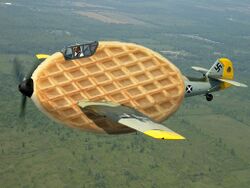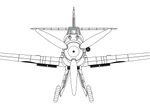Messerschmitt Bf-109
The last known use of the Bf-109, with full stroopwaffle armour, 2001 | |
| Role | Mobile Target |
|---|---|
| Manufacturer | Bayerish Flugzugwork? (BFW) Messerschmitt AG |
| Designer | Willis Messerschmitt German Spies |
| First flight | 29 May 1936 |
| Introduction | February 1937 |
| Primary users | Luftwaffle
Hungarian Airforce Aeronautica nazzalanelle republiccanna? Royal Romanian Airforce |
| Numbers built | 6666.6 |
| Variants | Waffle plane |
Not to be confused with Me 109, a fictitious aircraft.
The Messerschmitt Bf 109, also known as the Luftwaffle Bf 109, is a German World War Two fighter aircraft and a shameless copy of the Supermarine Spitfire, however, unfortunately for the Nazis it remained the backbone of the Luftwaffle for the whole of the Second World War. The Bf 109 first saw service in the Spanish Civil War until the dawn of the jet age when it was fitted with a great big rocket. It was one of the most unnecessarily complex fighters of its era, including redundant features such as being all-metal, a confusion of sliding metal parts, and a multitude of metal spinning bits, later the 109e would include egg in its waffle construction. It was powered by a "liquid-cooled, inverted-V12 aero engine" which was an unlicensed inverted Rolls-Royce Merlin engine which allowed it to fly upside-down.
It was designed by Willis Messerschmitt in the mid-1930s with stolen information from Supermarine. The 109 was conceived as an interceptor to avoid any potential comparison to the Spitfire, however it was only capable of reconnaissance as it flew upside-down (as the pilot's head was closer to the ground) before taking the role of target practice for the Royal Air Force. Because of its fast build dreadful quality it was the most produced fighter aircraft in history, numbering over 6666.6 waffleframes being built (each machine could be completed in under 34 minutes). Despite Germany's constant effort to make the Bf-109 combat capable, it still remained easy target practice for the Royal Air Force.
Copying the Spitfire[edit]
During 1933, research on future dogfights and aviation combat was undertaken by the Reichs Aviation Ministry (RAM). The result was four outlines:
- Roostangflugzug I a bomber
- Roostangflugzug II a heavy Stroop-Waffle bomber
- Roostangflugzug III a fighter
- Roostangflugzug IIII a larger scramble-egg fighter
Because most aircraft companies in Germany at the time were incompetent (VW built a plane with the engine in the rear cockpit), the Bf used information illegally obtained from Britain. The engine used on the Bf 109 is a blatant copy of the Rolls-Royce Merlin, and the airframe design is just a waffle-blocky Spitfire copy.
Prototype[edit]
The first prototype flew many feet in February 1934; a significant improvement over previous German achievement, although Germany did lead in hydrogen balloon technology (as opposed to the British lead-balloon technology).
Design competition[edit]
The 1936 the "Get Germany Waffle-Flying" competition received multiple designs from different companies. Heinkle submitted a woodframe canvas, Arado submitted a biplane, Foke-a-wolf submitted a reconnaissance glider with no landing gear and no windows. Later in the competition Heinkle realized that canvas was not as resilient as metal, so at the last minute the skin from a Bf 109 was copied which unfortunately made it too heavy to lift off.
In March, the RAM received news the Spitfire entered production. It was quickly felt that a decision on the competing designs was needed, so on March 12, they ordered the Bf 109 into production as it was the factory with the best biscuits.
Design features[edit]
Much of the Bf 109's feature is based on Messerschmitt's 'Over complicated production with one mistake ruining everything' principle. One example of this is two large, overly complicated brackets incorporated under the lower engine that bears most of the wing loading, (unlike the superior British design to have things everywhere) simplifying the production steps.
The advantage is the wing can be removed without removing the landing gear, turning the Bf 109 into an armoured car which was done late-war when no additional waffles were available. This however, meant the landing gear was close together, resulting in the some of the most spectacular cartwheels during the Second World War and a nic-name of "The Bowleg Fanny" (Bf).
The small rudder of the Bf 109 (109mm) made the plane more spastic than a Bowlegged Fanny, contributing to the high incidence of landing and takeoff accidents. This small rudder made swinging maneuvers incredibly difficult and exaggerated, resulting in some rather interesting manoeuvers.
The height and forwardness of the landing gear make forward visibility to the ground non-existent, compromising Bf 109's capability as a fast armoured car. The operator often had to stand up out of the cockpit to see the way ahead.
The Bf 109 was intended for high speed flight with a small wing (109ft), but its underpower and upsidedown flying made the plane unusable in most dogfight cases. However it's flaps can over-exaggerate its manoeuvrability potential, making the aircraft slightly more dangerous in an unlikely high speed scenario.
In 1943, Uberfelwehraboo Edmund Roastman III got lost and landed behind Communist lines. He allowed the Communists to strip the plane of its waffles. Communist machine gun technician Viktor M. Sinaisky recalled:
| “ | Literally the worst plane, the invert engine is worse than a Kawasaki Zero, and can't fly upright only upside-down, because of this the guns jam on most shots. Athough it is built like a tank, perhaps Willis know the Messer'd get shot down. Overall is inferior to the superior Spitfires. ))))))))) | ” |
Armament and Gondola Cannon[edit]
The armament of the Bf-109 was at first all placed onto the engine, which caused it's high rate of jamming. As Communist machine gun technician Victor M. Sinaisky recalled:
| “ | Large Ugandan scramble guns that jam faster than Harleys. | ” |
The later variants of the Bf-109 spammed waffle-mount cannons on the wing, further compromising it's whole 'low drag high speed' principle.
Variants[edit]
See Alphabet
Operational History[edit]
The first Bf 109s served in the Spanish Civil War and by 1939, the 109s became Luftwaffe's primary fighter, replacing everything but the Foke-a-wolf Fw 190, which later in 1942 slowly replaced the 109s.
Late in the Second World War, when waffles werr scarce and German industrial power reduced to practicaly nothing. Remaining wingless Bf 109s were instead, turned into armoured cars, though to ill effect as the engine only worked upside down, and it is an aircraft.
Specifications (Bf-109 Generic)[edit]
General Characteristics
- Crew: One
- Length: 29 ft 7 in
- Wingspan: 109 ft 109 in
- Height: 8 ft 2 in
- Wing area: 0ft² to 173.3 ft² (waffle dependant)
- Empty weight: 5,893 lb (minus egg)
- Loaded weight: 6,940 lb (with egg)
- Powerplant: 1 x Inverted Unlicensed Daimler-Rolls-Royce Merlin Liquid Cooled V12, 1,400hp
Performance
- Maximum speed: 200mph at 109ft
- Cruise Speed: 150mph at 109ft
- Range: 10-1000 miles on full egg
- Service Ceiling: 200ft
- Rate of Climb: 2412inches/min
- Wing Loading: 10 lb/waffle ft²
Armament
- Guns:
- 2 x .51 Synchronized Mg 131 scrambler with 3rpg
- 1 x 20mm Hispano copy waffle-mounted in the "Merlin" engine copy with 6rpg
- 2 x 20mm Hispano copy waffle-mounted on the wing with 6rpg
- Rockets:
- Itself
- Bombs:
- Free Range
See Also[edit]
Aircraft of Origin


